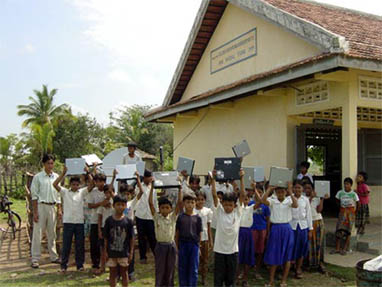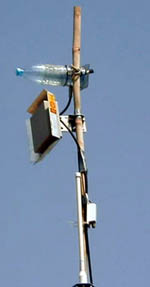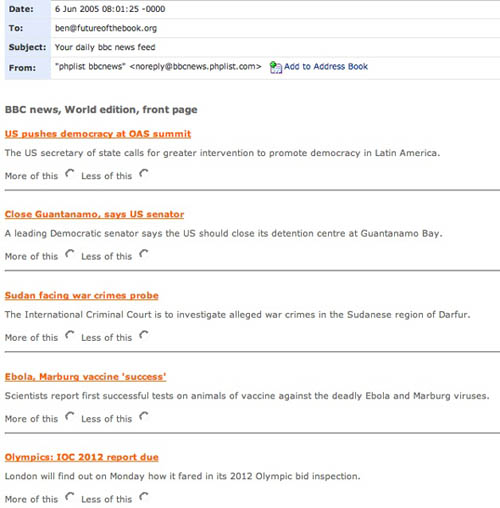Next week, as part of a general reworking of its editorial page, the LA Times is staring “wikatorials” – “an online feature that will empower you to rewrite Los Angeles Times editorials.”
(via Dan Gillmor)
UPDATE: “Upheaval on Los Angeles Time Editorial Pages” in NY Times.
Monthly Archives: June 2005
web news as gated community
Just found out about this on diglet.. Launched in April, The National Digital Newspaper Program (NDNP) is a joint effort of the Library of Congress and the National Endowment of the Humanities to create a comprehensive web archive of the nation’s public domain newspapers.
Ultimately, over a period of approximately 20 years, NDNP will create a national, digital resource of historically significant newspapers from all the states and U.S. territories published between 1836 and 1922. This searchable database will be permanently maintained at the Library of Congress (LC) and be freely accessible via the Internet.
(A similar project is getting underway in France.)
It’s frustrating that this online collection will stop at 1922. Ordinary libraries maintain up-to-date periodical archives and make them available to anyone if they’re willing to make the trip. But if they put those collections on the web, they’ll be sued. Archives are one of the few ways newspapers have figured out to make money on the web, so they’re not about to let libraries put their microfilm and periodical reading rooms online. The paradigm has flipped.. in print, you pay for the current day’s edition, but the following day it ends up in the trash, or wrapping a fish. The passage of 24 hours makes it worthless. On the web, most news is free. It’s the fish wrap that costs you.
The web has utterly changed what things are worth. For most people, when a news site asks them to pay, they high tail it out of there and never look back. Even being asked to register is enough to deter many readers. But come September, the New York Times will start charging a $50 annual fee for what it considers its most unique commodities – editorials, op-eds, and selected other features. Is a full subscription site not far off? With their prestige and vast readership, the Times might be able to pull it off. But smaller papers are afraid to start charging, even as they watch their print circulation numbers plummet. If one paper puts up a tollbooth, they instantly become irrelevant to millions of readers. There will always be a public highway somewhere nearby.
A friend at the Columbia School of Journalism told me that the only way newspapers can be profitable on the web is if they all join together in some sort of league and charge bulk subscription fees for universal access. If there’s a wholesale move to the pay model, then readers will have no choice but to shell out. It will be like paying for cable service, where each newspaper is a separate channel. The only time you register is when you pay the initial fee. From then on, it’s clear sailing.
It’s a compelling idea, but could just be collective suicide for the newspapers. There will always be free news on offer somewhere. Indian and Chinese wire services might claim the market while the prestigious western press withers away. Or people will turn to state-funded media like the BBC or Xinhua. Then again, people might be willing to pay if it means unfettered access to high quality, independent journalism. And with newspapers finally making money on web subscriptions, maybe they’d start loosening up about their archives.
uncyclopedia: the inevitable wikipedia parody

![]() Uncyclopedia is “the content-free encyclopedia that anyone can edit.” Its definition of “book” is actually kind of interesting: “Bound Offline Organized Knowledge.”
Uncyclopedia is “the content-free encyclopedia that anyone can edit.” Its definition of “book” is actually kind of interesting: “Bound Offline Organized Knowledge.”
“an invaluable resource that they had an extremely limited role in creating”
Good piece today in Wired on the transformation of scientific journals. There’s a general feeling that commercial publishers like Reed Elsevier enjoy unreasonable control over an evolving body of research that should be freely available to the public. With exorbitant subscription fees, affordable only for large institutions, most journals are effectively inaccessible, and the authors retain few or no reproduction rights. Recently, however, free article databases have sprung up on the web – The Public Library of Science (PLoS), BioMed Central, and NIH’s PubMed – some of which, like PLoS, have begun publishing their own journals. It’s a welcome change, considering how much labor and treasure is poured into scientific publications (from funders, private and public, and from the scientists themselves), and yet how little is gotten in return. Shifting to a non-profit model, as PLoS has done, preserves much of the financial architecture that supports the production of journals, but totally revolutionizes the distribution.
PLoS journals are free and allow authors to retain their copyrights, as long as they allow their work to be freely shared and distributed (with full credit given, naturally). They also require that authors pay $1,500 from their grants, or directly from their sponsors or institutions, to have their work published. These groups pay the bulk of the $10 billion that goes to scientific and medical publishers each year, and what do they get in return? Limited access to the research they funded, and no right to reuse the information.
“It’s ridiculous to give publishers complete control of an invaluable resource that they had an extremely limited role in creating,” Eisen said (Eisen teaches genetics and is a founder of PLoS).
But what is in many ways the tougher question is how to shift the architecture of prestige – peer review – to these new kinds of journals.
Something is happening here but you don’t know what it is, do you, Mr. Jones?– me either for that matter.
 Came across this on a web-site i’d never heard of while searching for audio samples of a sound artist i’d never heard of (Todd Dockstader) that was referenced in a copy of magazine called The Wire that i purchased for the first time.
Came across this on a web-site i’d never heard of while searching for audio samples of a sound artist i’d never heard of (Todd Dockstader) that was referenced in a copy of magazine called The Wire that i purchased for the first time.
Stacked in almost innumerable dusty piles around my room are the incoming CDs of many a publicist’s hardwork & toil. And for reasons that have more to do with esoteric alignments of the stars than any particular dislike, they often remain untouched & unheard for far, far too long. This very column is somewhat of an attempt to remedy this situation while also commenting on the sheer volume of music, especially electronic music, that continues to be released. It’s a deluge of expression via our machines, which has resulted in an inverse response of criticism, a lack of perspective, an inability to perfect the zoom-out on the overall picture of what is being produced by this wired and wireless culture. . .
— tobias c. van veen in cut-up
reminded me for the 323rd time in the past several months that something profound is happening relative to the “sheer volume” of media being produced and new (online) distribution patterns. would love to start to understand the ramifications. here’s one i see in my own behavior — and you can’t imagine how painful it is to own up to this:
in 2001, 2 and 3 i made a scrapbook of things i collected on the web. i included in the scrapbook a record of all the books i read cover-to-cover. each year the number was at least 24. suddenly in 2004 the number went to ONE, and that was a graphic novel that i read in a few hours.
i’m still reading quite a bit but most of it is online and in much smaller chunks than books or even long articles. but also, with the advent of big notebook computers with dvd drives and large screens, some of my reading time has been supplanted by watching time as i’ve begun to absorb TV series (sopranos, 24, Six Feet Under) — viewing all the segments in as few sittings as possible, much like the experience of a page-turner novel.
i’m also browsing quite a bit more. when i was a teenager i went to the record store (yes, i’m that old) and would spend quite a long time choosing one or maybe two to buy. then i would bring those home and listen to them over and over and over. now i find i hardly ever have to come out of browsing mode. between othermusic.com, earplug, etc. etc. a scary amount of my conscious music listening can be subsumed by surfing for new sounds.
i’d like to find a way to get people to talk about their media consumption so that we can begin to understand what actually is happening, not just quantitatively, but qualitatively.
any suggestions?
(image by Gregory Vershbow)
multimedia promo or prose poem?

![]() Novelist Micheline Aharonian Marcom has created a website that presents brief excerpts from her novel, Three Apples Fell From Heaven, as audio flash drawings that combine animated text, audio and illustration. The illustration, a red line that scribbles randomly on the screen, subtly alludes to the violence in the text, and the voice-overs add depth to an already intense story. Although this site was only intended as a promotional piece for Marcom’s first two novels, the excerpts she chose and the impact of the sound and illustration makes them feel more like prose poems.
Novelist Micheline Aharonian Marcom has created a website that presents brief excerpts from her novel, Three Apples Fell From Heaven, as audio flash drawings that combine animated text, audio and illustration. The illustration, a red line that scribbles randomly on the screen, subtly alludes to the violence in the text, and the voice-overs add depth to an already intense story. Although this site was only intended as a promotional piece for Marcom’s first two novels, the excerpts she chose and the impact of the sound and illustration makes them feel more like prose poems.
the 2005 computers and writing online conference
The Institute for the Future of the Book is presenting a paper at the 2005 Computers and Writing Online Conference. Our presentation, entitled “Sorting the Pile: Making Sense of A Networked Archive,” discusses our experience building a networked archive for our Gates Memory Project and the insights it provided regarding the evolution of books in the networked environment.
The conference began on Tuesday, May 31, and runs through Monday, June 13. It is an online conference that is open-access, Creative Commons-licensed, and hosted on a weblog. Drawing upon the conference’s theme of exploring the increasing value of the network and collaborative practices within it, presenters examine the role(s) played by social networking applications and other technologies that are intended to foster social interaction, community, and collaboration. Alongside studying the technologies themselves, presenters will observe and describe the ways that writers and users are engaging the technologies and how such engagement is changing our ideas about writing and teaching writing, and, more broadly, the concepts of rhetoric and composition themselves. We very much hope you’ll get involved by leaving your comments, or, if you prefer, respond on your own weblog and leave a trackback! Or write a response on your wiki! Or tag presentations on your del.icio.us or de.lirio.us list! You get the idea. This conference is meant to be networked.
The presentations are accessible to anyone with an internet connection, and anyone with an account at Kairosnews (registration is free) can leave comments. For more information, visit the CW Online 2005 weblog.
book DJs: hear penguin, sample penguin, remix penguin
First there was the DJ, then the VJ, now Penguin audio books is sponsoring “penguin remixed” a contest that might spawn a whole new genre–are you ready for the BJ ?
According to the website, “thirty of the best spoken word samples from some of the greatest books of all time and the finest actors around.” are available for remix. “Download the samples, use them in your music, submit your tracks. The ten top tracks, as voted by you, will be turned into a Penguin digital audiobook, which will be available through the Audible.co.uk store and via iTunes UK.”
Just to get your creative juices flowing, here is one of the samples available for remix. It’s from Lewis Carroll’s, “Alice in Wonderland,” read by Susan Jameson.
building frontier networks
The $100 laptop project – the MIT-led initiative to distribute cheap, network-enabled computers to schools throughout the developing world – is moving ahead, but it’s far from clear whether it will succeed. Today Wired discusses some of the daunting physical challenges of deploying technology in places where there isn’t even electricity, let alone a wireless broadband network. As far as energy is concerned, the MIT team is trying to make the computers as self-sustaining as possible, experimenting with hand cranks (like a wind-up watch) and “parasitic power,” where the user’s typing constantly charges the battery. Then there is the problem of networks. The vision driving the project is one of delivering the resources of the web to communities that are cut off from libraries and the general flow of information. But extending the gossamer strands of the web requires robust architecture. Dumping cheap laptops in village schools won’t achieve much if you can’t connect the dots.

![]()

Wired mentions geekcorps, a group that coordinates skilled technology volunteers around the world “to teach communities how use innovative and affordable information and communication technologies to solve development problems.” One of their trademark innovations is the “BottleNet” – a method for setting up improvised Wi-Fi relay networks with “do-it-yourself antennas,” first employed in geekcorp’s Mali project:
The do-it-yourself (DIY) antenna designs were based on information gathered from numerous sources, including standard ham radio operator reference manuals, books on building wireless community networks, numerous DIY wireless sites on the Internet, and from the past experiences of GCM volunteers with wireless antennas. Changes to the designs were made to incorporate materials that are easily available in Mali (plastic water bottles, used valve stems from motorbikes, window screen mesh, television and low cost coaxial cables, etc.) to minimize the technical skills needed to build an antenna and to reduce costs.
Something about these ad hoc creations, patched together with junk – the scraps of western industry – speaks eloquently of the fragility of our grand networked enterprise.
images: (left) kids with Panasonic Toughbooks at the Nicholas and Elaine Negroponte School in Cambodia (from Wired); (right) BottleNet antenna in Mali
Bayesian news by email
Another interesting prototype from BBC Backstage: news feeds delivered by email with Bayesian filtering. In other words, you can flag the kind of messages you want to receive more of, and the kind you want to receive less of, purifying the signal, as it were. This kind of filtering was first developed to deal with spam. Here’s what it looks like in your mail viewer:

